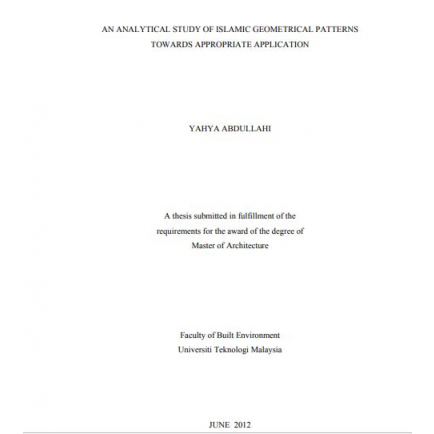
An Analytical Study of Islamic Geometrical Patterns Towards Appropriate Application
Date Added
25/07/2019
Content Type
Dissertation
Category
Masters
Link to Content
Subject Area
AN ANALYTICAL STUDY OF ISLAMIC GEOMETRICAL PATTERNS TOWARDS APPROPRIATE APPLICATION
Author
YAHYA ABDULLAHI
Description
Although Islam gives function and not form, but Islam as a context has effects on forms and ornaments in some ways. The great role of geometry in Islamic architecture due to restriction of using natural figures is an example. In this research, the application of Islamic geometrical patterns (IGPs), and suitability of their usage over architectural elements is studied. For this purpose, evolution of IGPs through history has been studied, while regional diversities are also taken into account.
The research not only identifies origin of patterns but also reveals radical artistic movements through history of Islamic architecture. Therefore, suitability of patterns in terms of time-scale accuracy and period-style has been identified. The next step is focused on building elements and areas where patterns are applied. A survey of decorative patterns of hundred well-survived buildings through Muslim world of architecture has been conducted for this purpose, which reveals the types of patterns that are mostly used over different building elements.
Then, the geometrical properties of the patterns are studied to find their similarities and differences. The results show, although IGPs are seems to be infinite types, however they are limited in terms of geometrical properties and can be classified. Therefore, the most prominent and widely used patterns collected have been analyzed further, based on their constructive polygons and polygon-tilings. It eventually simplified their overall view, which had significant help for their classification. It also helps to understand direction and nature of expansion of each pattern.
The result also indicates that each
pattern has a particular perfect outline proportion. For example, for a given
dimension, not all, but particular patterns can be selected to fit and fulfill the area in
a perfect proportion and without deformity along edges of a given area. Finally, this
research managed to find guidelines to choose and fit IGPs into certain given areas
over finishing surfaces of building elements.
Files
English & Malaysian.
YAHYA ABDULLAHI
Faculty of Built Environment - Universiti Teknologi Malaysia
2012





